The Rise of Right-Wing Propaganda
Commentators peddling non-facts are crowding out thoughtful conservatives.

President Barack Obama signs H.R. 2751, the “FDA Food Safety Modernization Act,” in the Oval Office, Jan. 4, 2011. Official White House Photo by Pete Souza. Photo is in the Public Domain.
Shortly after the start of the new year, the Journal Sentinel published an op ed attempting to prove that, in the words of its title, “Obama has been a disaster.” The column by Justin Haskins, executive editor of The Heartland Institute, described as “a think-tank devoted to free enterprise,” is worth examining, not because its arguments are particularly cogent or unique. Rather it does an excellent job of demonstrating the depths to which some conservative institutions have sunk.
Early in the column, the following paragraph appears:
After nearly eight years in office, though, Obama has failed to deliver on many of his campaign promises and has left America worse-off than it was when he entered the White House.
This extraordinary claim depends on the reader’s amnesia about what was happening when President Barack Obama entered office in January 2009. The American economy—and much of the world’s–was in free fall. Jobs were being shed at a rapid rate. Credit was locked up.
The first graph here is Eichengreen and O’Rourke’s chart of global production in the Great Depression (the blue line) and the first nine months of the Great Recession (shown in red). The two lines start at 100 percent of industrial production (the peak) and by the time they hit the point ten months later (the months are tracked on the line at the bottom), the Great Depression is at 92 percent of peak production while the Great Recession was even lower, at 88 percent of peak production.
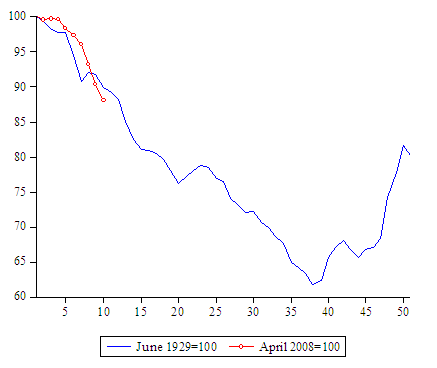
Global production in the Great Depression (the blue line) and the first nine months of the Great Recession
The next graph compares the behavior of the global stock market. Once again the blue line is for the Great Depression, and you can see the stock market actually rose above its beginning point (100) but ten months into the depression (again the months are numbered on the bottom line) the market had dropped to about 90 percent of its beginning point. By contrast, the Great Recession (the red line) had dropped to about 50 percent of its value in just 10 months.
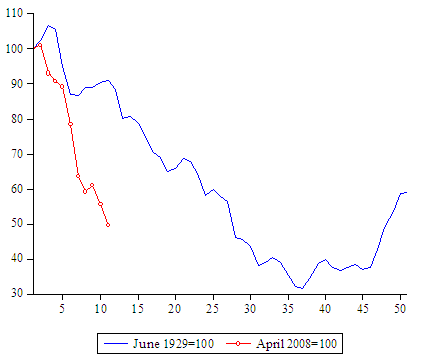
Stock Market in the Great Depression (the blue line) and the first nine months of the Great Recession
Finally there was world trade. In the author’s words, this was “another area where we are ‘surpassing’ our forbearers is in destroying trade.” World trade was down to about 83 percent of its peak value (100) by early 2009 compared to about 95 percent of the peak 10 months into the Great Depression. In all three cases the Great Recession had more horrible numbers, which Obama inherited, than those of the Great Depression.

World trade in the Great Depression (the blue line) and the first nine months of the Great Recession
Whatever one thinks about the recovery under Obama, to claim that things are worse today than in January 2009 depends on willful forgetfulness on both the author’s and reader’s part as to the situation in early 2009. The claim that “America is worse off” than when Obama entered office has to be classified as “Pants on Fire,” to adopt the PolitiFact terminology, or “Four Pinocchios,” in the language of the Washington Post’s Fact Checker.
To buttress his claim that America is worse off, Haskins argues that jobs have lagged population growth:
Since January 2008, the U.S. population has grown by more than 20 million but the number of jobs has increased by less than 7 million, meaning despite Obama’s boasting about alleged job growth, the number of jobs created has failed to keep up with population growth, normally considered a poor economic indicator.
The next chart shows job growth using two different starting points. The first, in green, starts January 2008, a year before Obama took office, which was the pre-recession peak. The second, in orange, measures growth from January 2009, Obama’s first first month.
While job growth has lagged total population growth, demographic changes account for much of this. The oldest baby boomers are now in their seventies. This is reflected in the right-hand column, showing growth in the population who are of working age, between age 15 and 65, which grew by only seven or eight million, depending on one’s starting point. Thus, when the working age population is considered we are now slightly behind the pre-recession peak and slightly ahead of when Obama took office. By considering the entire population, including millions of retired baby boomers, Haskins presents a picture of a huge jobs gap that doesn’t exist.
The Great Recession had a devastating effect on jobs. As the next chart shows, jobs peaked at 138 million in early 2008. They declined to 134 million when Obama took office in January 2009, and continued declining for another year to just under 130 million. Since then jobs have steadily, if slowly, grown, hitting 145 million last November. That’s a huge turnaround.
Even after the number of jobs started growing, pay continued to decline. Recently, average pay in real terms has grown until, in real dollar terms, it exceeds the previous peak.
Finally, the growth of jobs has brought down the unemployment rate to the third lowest value since the 1970s, as shown in the chart below (the green bars show recessions). True, one might question how much of a decline may be due to discouraged workers dropping out of the labor force as compared to people getting jobs. However, to assert that US unemployment is worse is a willful attempt to mislead.
Haskins runs through a variety of issues. Beyond a simple assertion that Obama is to blame, he offers little or no analysis or evidence. These claims include:
- Growth in the gross domestic product has not exceeded 3 percent a year
- More people are out of the workforce
- Food stamp enrollment is up
- Fewer people own their homes
- Rising undergraduate tuition and student loan debt is largely due “to the Obama administration’s government takeover of the student lending industry”
- “The president’s signature legislation, the Affordable Care Act, has also been a disaster”
He concludes by claiming, “Happily, Republican opposition has been able to keep the president at least partially grounded.” The possibility that this opposition may have contributed to some of the ills he listed, notably the slowness of the recovery, doesn’t seem to have crossed Haskins’ mind.
In recent years, the Journal Sentinel, along with many of its peers, fact-checks statements from politicians and other public officials. The Haskins article points out the need to fact check articles that appear on its editorial page as well.
The newspaper’s desire to offer a variety of viewpoints is admirable. However, printing as “facts” claims not tied to evidence does its readers a disservice.
A good start would be to require authors of opinion pieces to link factual assertions to the sources of the data used. This would allow the reader to easily check their claims. Are the claims backed up? Does they leave out important contextual information?
The practice of printing propaganda disguised as analysis is also doing a disservice to conservatives. Underlying the publishing of conservative-oriented material that includes false information is an implicit assumption: that this is the best conservatives can do. By doing so, the paper propagates an unspoken libel on conservatives: that there is no such thing as an honest and thoughtful conservative.
The Niskanen Center offers interesting perspective on a variety of issues from a libertarian perspective. (Niskanen chaired the Cato Foundation). Recent examples of articles I found provocative were one on climate change and the carbon tax and another examining the pros and cons of a universal basic income.
On its urbanism page the American Conservative offers a number of thoughtful articles, that contradict the usually accurate generalization that conservatives love sprawl.
Both are examples that help demonstrate that evidence-based conservatism is not an oxymoron. Doing so, however, requires a willingness to examine all evidence for and against a position. Far more common—and the Heartland column is a prime example—is to treat evidence as a weapon and include only the evidence that supports a pre-determined opinion.
Unfortunately, when facts are treated as opinions and opinions as facts, it becomes very hard to develop any sort of consensus on how to solve problems.
Correction: The original version of this story mistakenly compared population and job growth by using two different time periods and wrongly questioned Justin Haskins’ data in those two categories. We apologize for the errors.
Data Wonk
-
Why Absentee Ballot Drop Boxes Are Now Legal
 Jul 17th, 2024 by Bruce Thompson
Jul 17th, 2024 by Bruce Thompson
-
The Imperial Legislature Is Shot Down
 Jul 10th, 2024 by Bruce Thompson
Jul 10th, 2024 by Bruce Thompson
-
Counting the Lies By Trump
 Jul 3rd, 2024 by Bruce Thompson
Jul 3rd, 2024 by Bruce Thompson

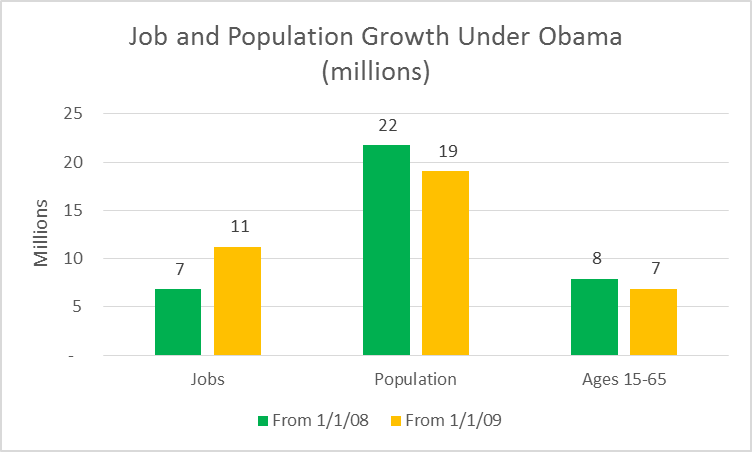
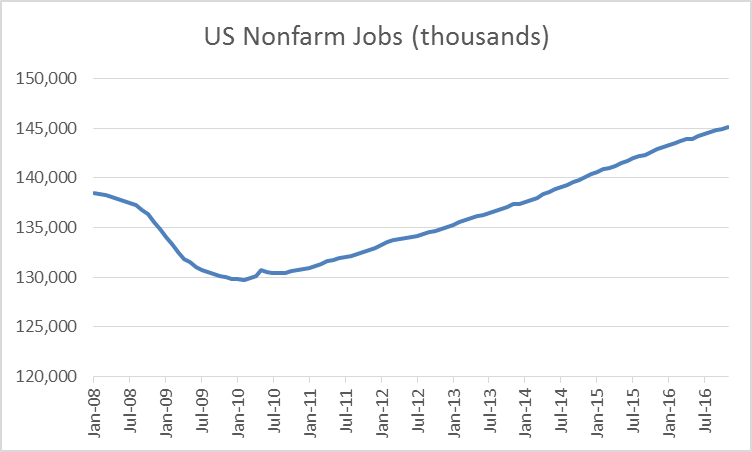
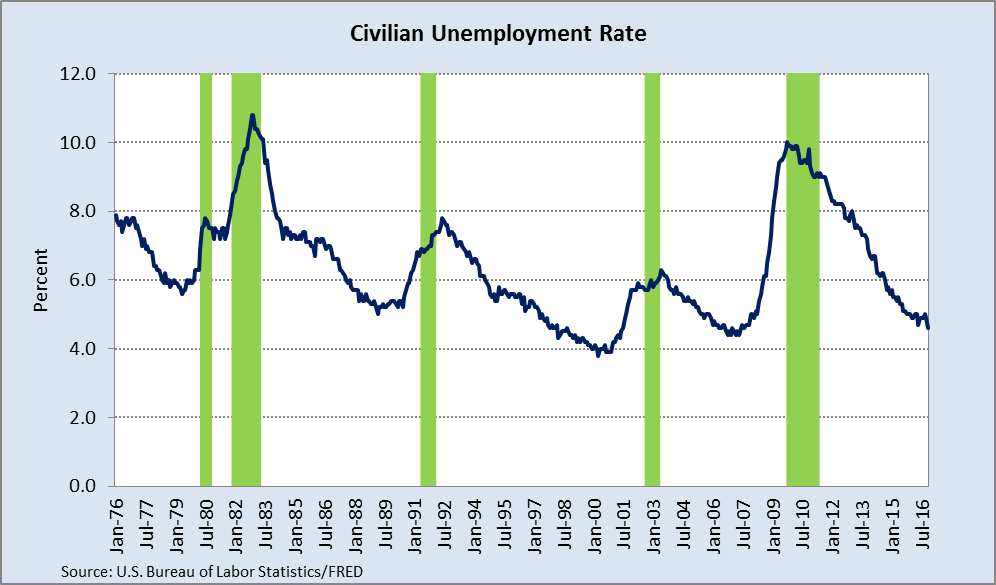















Good piece, but why did the JS publish such a factually challenged editorial from The Heartland Institute when there were other conservative options available?
Thank you, Bruce, for this column of corrections to a badly written and terribly inaccurate opinion piece. Thanks, too, for recognizing the Journal Sentinel’s habit of publishing right wing “commentary” pieces that are long on spleen and short on fact. This isn’t the first such utterance from Heartland Institute.
Why does the Journal print work that is demonstrably false and so obviously hostile? Is this a strategy to mollify a certain demographic?
I’m for tough outside commentary if 1] it is based in reality and 2] if we get to read opinions from different ideological camps. Seems that the citizens living in a metro region with only one daily newspaper deserve a range of high quality comment.
The Heartland Institute is a right wing ethically challenged propagandist mill. Last year The Wisconsin State Journal published an op-ed from one of their “interns” claiming that testing by the institute indicated that there was no health risks from the mining of fracking sand to downwind neighbors, since their testing indicated no escaping particles of consequence from the mine sites. Research done by a U W Eau Claire Professor and his students indicated exactly the opposite. The health risk is due to the smallest particles, which are ingested by breathing. The testing by the Heartland Institute used filters that were too large to trap and detect the dangerous particles , almost certainly by design. The Heartland Institute has previously published research downplaying the dangers of cigarettes, and firearms., Their funding in general comes from the industries or interests who wish to have favorable research or comment from the Heartland Institute. They generally are not disappointed. The real tragedy is the Journal Sentinel, which has has lost its moral way years ago. No ethical newspaper would have only one op-ed writer, the highly partisan right wing hack Christian Schneider on their staff , without a corresponding voice from the opposing side. The Journal Sentinel brazenly does so on a daily basis. To paraphrase George Orwell, “if the lie is told often enough, it becomes history and then becomes the truth”.
Great commentary Bruce. Please note today’s (1/19/2017) edition of the Journal Sentinel has another similar Op-Ed piece “Making America Great” written by Jay Ambrose, a columnist for Tribune News Service, that similarly labels the Obama presidency as a disaster. He makes a very weak attempt at admonishing Donald Trump but in the end his main focus is stating that what President Obama has accomplished needs to be reversed. Again the Journal Sentinel fails to present a balanced viewpoint, neglects to fact check a prominent Op-Ed piece, and continues to be a forum for distorted facts.
Hack journalism at it’s finest. Both the Heartland Institute and more depressingly the Milwaukee Journal-Sentinal. Both are on the same spectrum of right wing propaganda.
Yet another well-researched, fact-based, and thoughtful piece from you, Bruce. Keep up the good work.
Fake news, like you can keep your doctor, you can keep your health plan or your premiums wont go up. I like to thank the leftist media for peddling that turd.
You’re thanking the media for reporting things President Obama said? That’s the best you can do here?
Jason, do you actually believe the things you write or do you just try to deceive other people?
Jason, I think you meant to put your errr… comment… on a different article.
“You’re thanking the media for reporting things President Obama said? That’s the best you can do here?”
It’s par for the course. I don’t think I’ve ever seen a conservative address any actual points. They tend to just go off on unrelated insult tirades. Like a lost child with turrets.
errr… tourette’s.
Amen to Dennis G’s post # 6 that this is a “well researched, fact based and thoughtful piece.” Yesterday’s rant by the current press secretary against the press reporting factually that the 1/17 inauguration was not well attended, when contrasted with the 1/09 inauguration – despite photographic evidence that the crowd in 2017 was maybe half the size of the 2009 crowd – reinforces the observation of many that our current president has little regard for facts.
Keep facts alive.